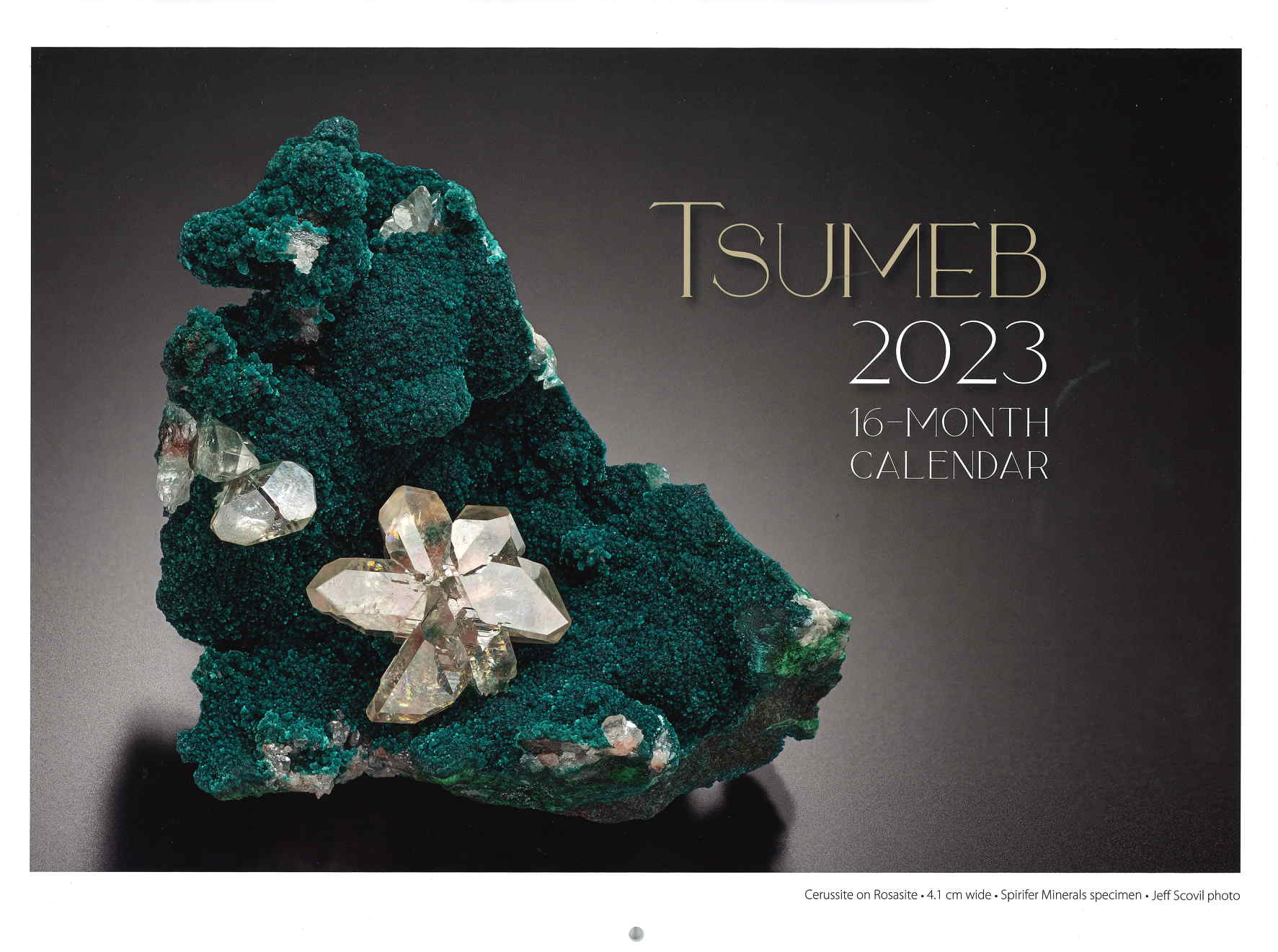
Mineralogical Society of America, Founded December 30, 1919
Order Publications Online (25% discount for MSA, CMS and GS members, except shipping)
Limited numbers of the 2012-2022 calendars are still available.

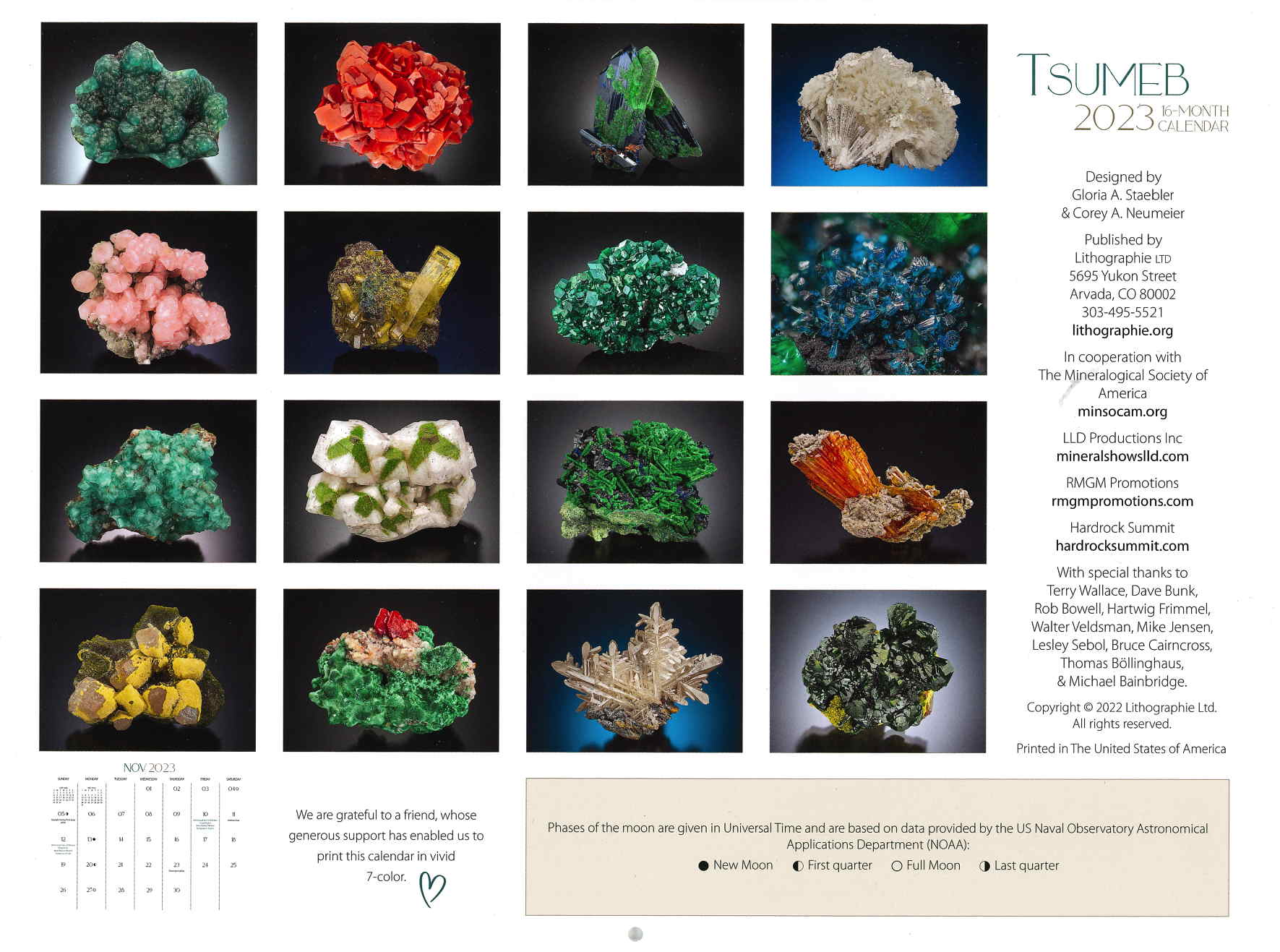
2023 Calendar: Tsumeb - The King of Mineral Localities, a 16-month calendar.
From the Preface:
Six hundred million years ago, the southern part of Africa was involved in a continental reassembly, driven by plate tectonics. In the process of forming the large continent Gondwana, two ancient continental land masses — the Congo and Kalahari cratons — collided. The cratons "sutured" during the Damaran orogeny, and the ensuing tectonic activity initiated deep-seated magmatic activity, deformation, and metamorphism that set the stage for mineral-laden fluids to percolate through ancient limestone and dolomite to form the backbone of the Otavi Mountainland.
Over the next half billion years, the Otavi Mountainland underwent numerous episodes of deformation, including folding, faulting, and most importantly the development of karst topography. The entire region is filled with polymetallic mineral deposits, which number north of 600 . Tsumeb, however, stands out both in size and mineral diversity. The Tsumeb deposit is a pipe-like structure in which the primary sulfide ores were concentrated. Meteoric waters percolated through the host limestone/dolomite and dissolved the carbonates, creating sinkholes and cavities, and laying the groundwork for a most unique mineral deposit.
The fluctuating water table altered the primary sulfide minerals and created at least three distinct oxide zones filled with the colorful secondary species that have made Tsumeb famous. Mineral specimens from these zones are represented in every major collection in the world, and no fewer than 489 different species, representing some nine percent of all defined minerals, have been identified from the locality. Seventy-two of those species were first identified at Tsumeb; an astonishing forty of them have not been found anywhere else in the world. And the deposit continues to surprise as fresh analyses of specimens long-ago mined increase the suite of minerals known from this important and storied locality.
And diversity is only part of the story: the extraordinary range of colors and exquisite beauty of Tsumeb's minerals testify to the unique set of circumstances that gave rise to the deposit. There is common agreement among mineral collectors that Tsumeb produced the very finest examples of nearly 100 species. From the outrageous color and size of its sole type specimen of andyrobertsite (right) to the mine's namesakes tsumebite and tsumcorite to its rainbow of calcites and smithsonites and its mind-blowing pseudomorphs, Tsumeb reigns as the "King of Mineral Localities."
The calendar is published by Lithographie, LLC in cooperation with Denver Area Gem & Mineral Show, Fine Mineral Shows, LLD Productions, Inc., The Mineralogical Society of America, RMGM Promotions, and Tucson Gem and Mineral Society
=============================================================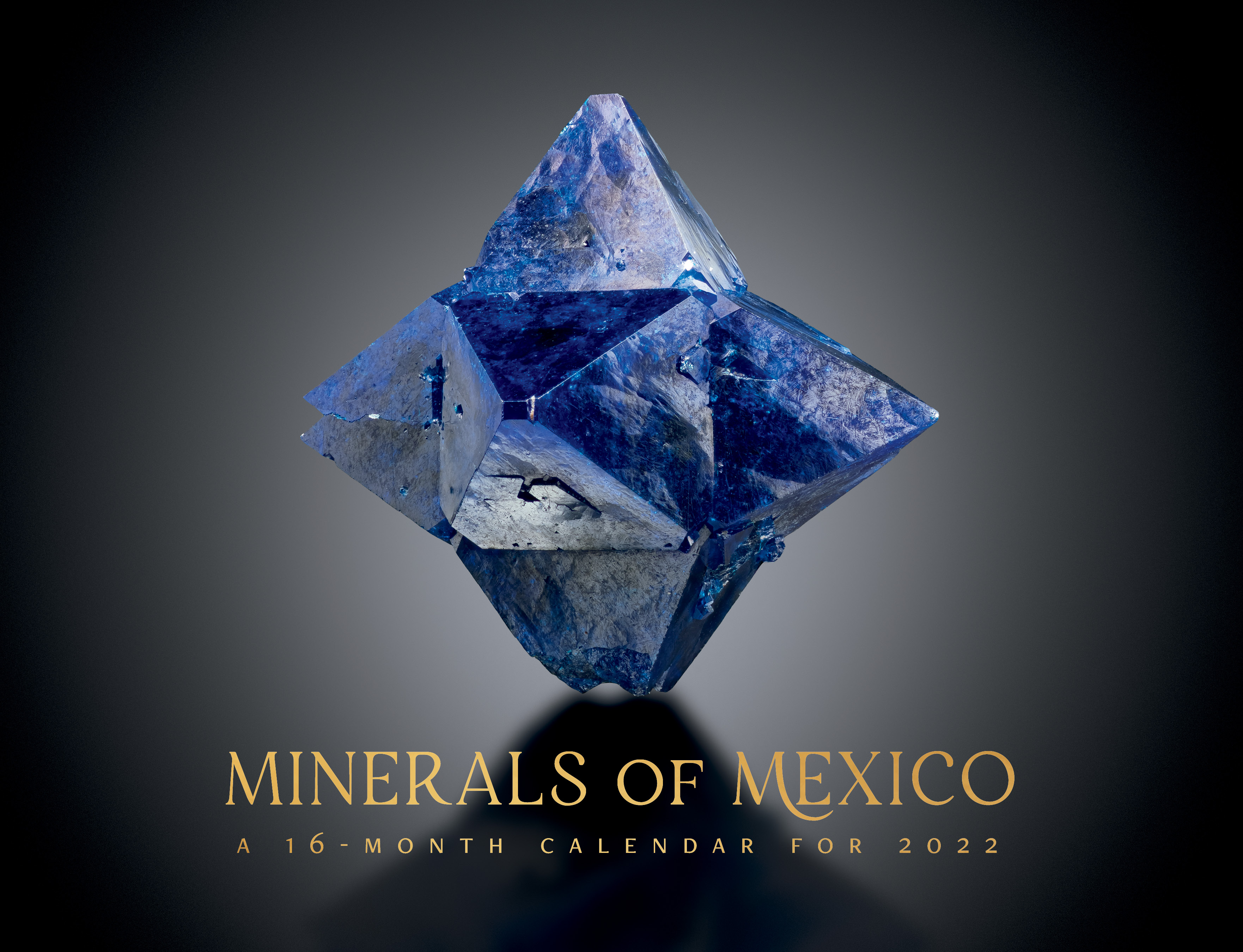
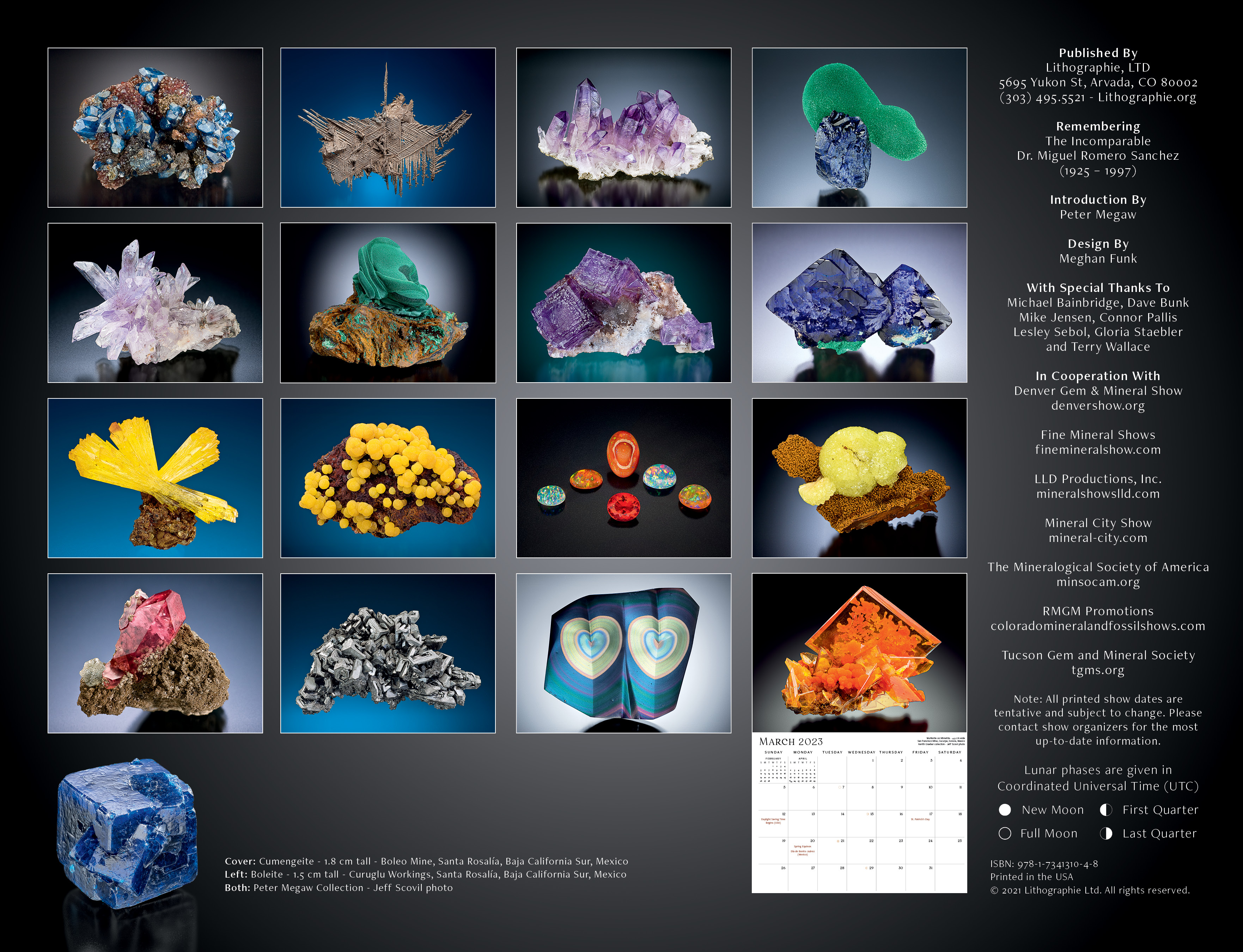
2022 Calendar: Minerals of Mexico, a 16-month calendar.
Author: Meghan FunkPeter Megaw
From the Lithographie website:
Boasting a mineralogical richness that almost matches her vibrant culture, Mexico is endowed with specimen localities that have yielded a spectrum of exceptionally well-developed minerals, common and rare. Home to nearly 80 type-species, Mexico is striped from north to south, west to east, and top to bottom with world-class specimen occurrences; many of these are found in the mines that underpin her economy, history, and cultural evolution. Separating Mexico from her mining and mineralogical heritage would be, as they say in Mexico como tacos sin tortillas, "like tacos without tortillas."
From north to south, Mexico's mineralogy mirrors the "Pacific Ring of Fire," the belt of volcanoes and intrusions that developed above the subduction zone that once ran uninterrupted along the west coast from the United States to Guatemala. The giant volcanoes and the magma chambers beneath their summits gave us a dazzling array of minerals: from opals to apatites, gold nuggets to agates — treasures that have been prized for centuries. Metallic ore deposits related to those intrusions have yielded more than 25 percent of all of the silver mined in human history — miners have been bringing home important specimens like the "blood of the bull" (pyrargyrite), along with amethyst and calcite, from these deposits for 500 years! Moving from west to east, vein deposits give way to replacement and basin-brine ore deposits; products of gradual changes in magma chemistry and radical changes of host rocks with distance from the subduction zone. The ubiquitous amethyst and calcite are joined here by garnets, fluorites, creedites, pink apophyllites, rhodochrosites, datolites, and danburites.
Ultimately however, because much of Mexico has been geologically stable for eons, top to bottom may be the most important bearing for lovers of Los Colores, Mexico’s brightly colored and well-crystallized oxide minerals. This stability has allowed surface waters to penetrate deeply and convert those silver-rich primary metallic ores to a rainbow of secondary species — many, the best in the world. From these oxidation zones sprang the reds, oranges, and yellows of Mexico's famous wulfenites, mimetites, and vanadinites; the deep blues and greens of her azurites, malachites, and brochantites; and the lighter blues to purples of her aurichalcites, smithsonites, and adamites.
As prevalent as this panoply of colorful species are in our collections, let's not forget the products of a truly unbridled Nature manifested in the world's first true international mineral celebrities — the 14-meter-long transparent gypsum behemoths of Naica's Cave of the Crystals — that none of us will ever see in captivity!
The calendar is published by Lithographie, LLC in cooperation with Denver Area Gem & Mineral Show, Fine Mineral Shows, LLD Productions, Inc., The Mineralogical Society of America, RMGM Promotions, and Tucson Gem and Mineral Society
=============================================================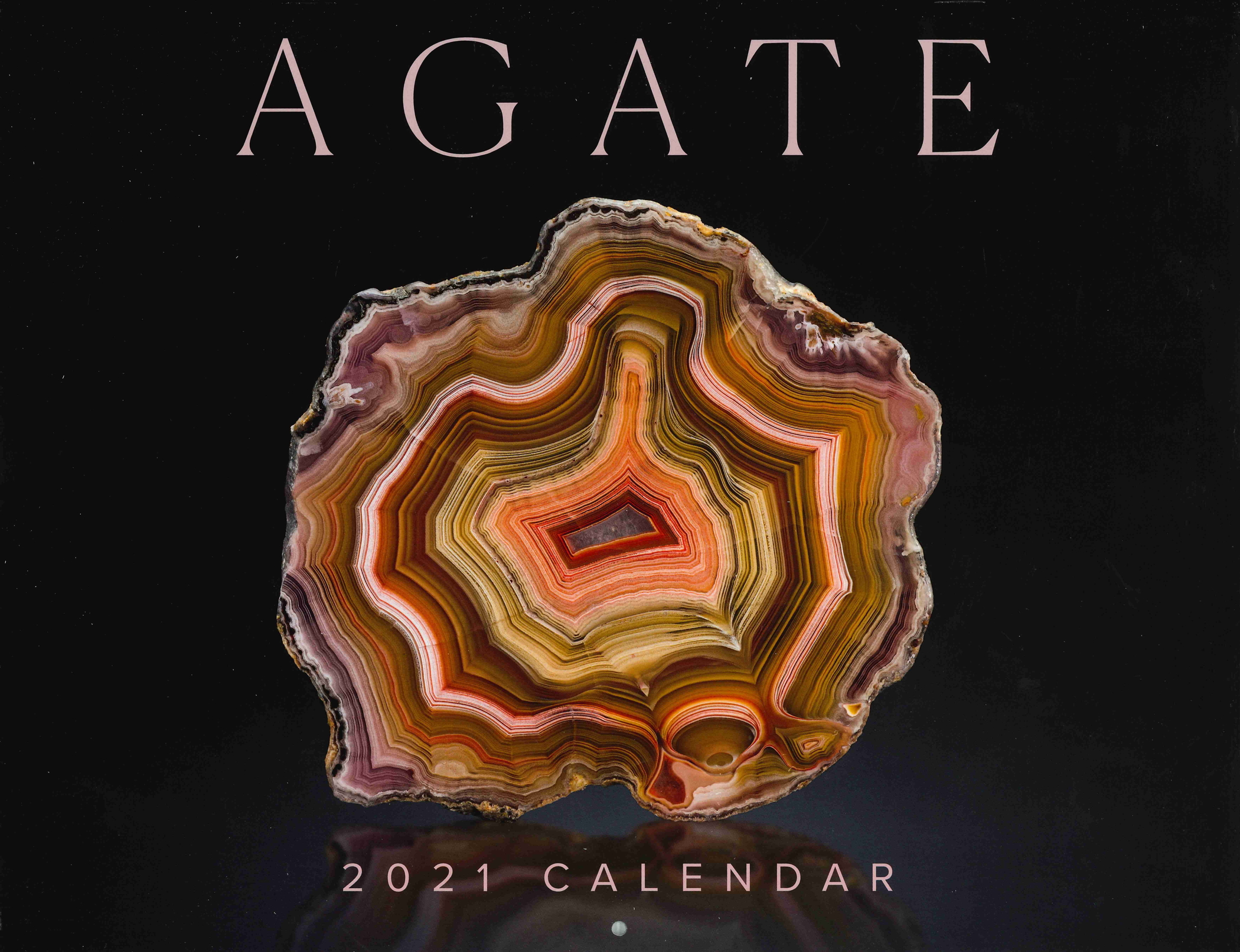
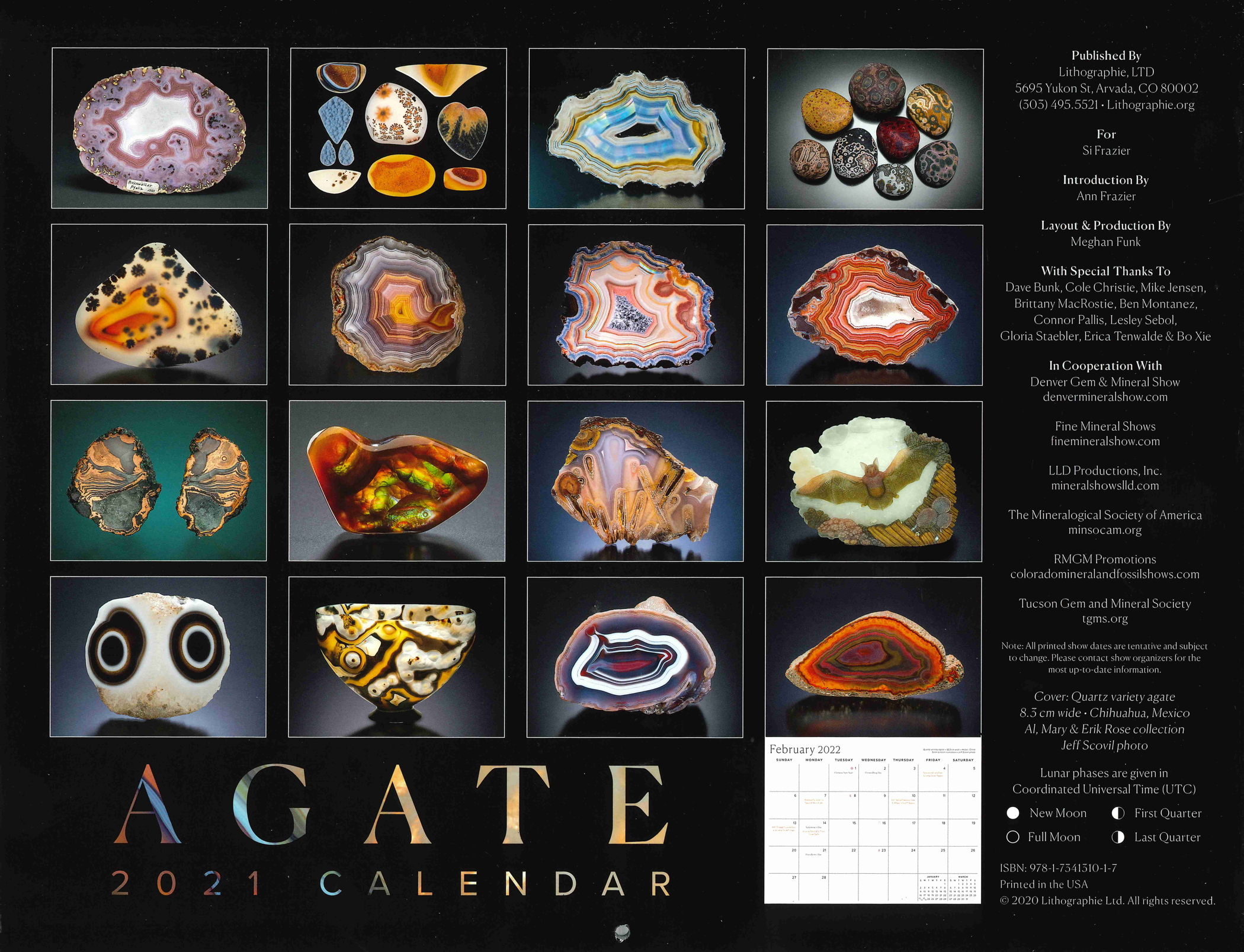
2021 Calendar: Agate, a 13-month calendar.
Phenomenal Agate, Ann FrazierAgate is easily among the most fascinating, intriguing, and beautiful gem materials and has been known for a very long time. Thought to be a potent talisman, agate and its cryptocrystalline quartz counterparts have been mediums of choice for carvers of intaglios, cameos, seals, beads, and other stone objects from Ancient Mesopotamia to modern ldar-Oberstein (Germany). Agate was so well esteemed in Biblical times that it was at least one of the stones described as bedecking the High Priest's breastplate (Book of Exodus). Indeed, for millennia, agate has enjoyed the mythos and tradition surrounding birth and natal stones and was set aside in just the last century in favor of more expensive gems.
A testament to its place in the gemstone canon, agate has been treated to enhance its color for more than 4,000 years. Its durability has made it a perfect material for utilitarian objects such as arrowheads, scrapers, and projectile points, which have been found in archaeological sites across the globe. More recently, agate has found use in precision instruments such as balances.
Agate is a variety of chalcedony, which is itself the cryprocrystalline variety of quartz. It is generally banded, colored by iron or other oxides. It is also translucent to transparent, differentiating it in the trade from jasper, which is usually opaque. Agate is found worldwide and is relatively common; still aficionados are insatiable and are thrilled when agate from a new locality such as Morocco or China comes onto the market.
Nature, in her infinite wisdom, has provided us with agate that exhibits an amazing array of patterns, many of which still baffle scientists. We collect agate for its banding: eyes, dendrites, and other interesting phenomena as well as for the pareidolias we see in it. Best of all, agate is a colorful, collectable, cuttable, and always wearable gem material. Agate is truly one of the most fascinating, curious, intriguing, and beautiful of earth's natural treasures!
The calendar is published by Lithographie, LLC in cooperation with Denver Area Gem & Mineral Show, Fine Mineral Shows, LLD Productions, Inc., The Mineralogical Society of America, RMGM Promotions, and Tucson Gem and Mineral Society
=============================================================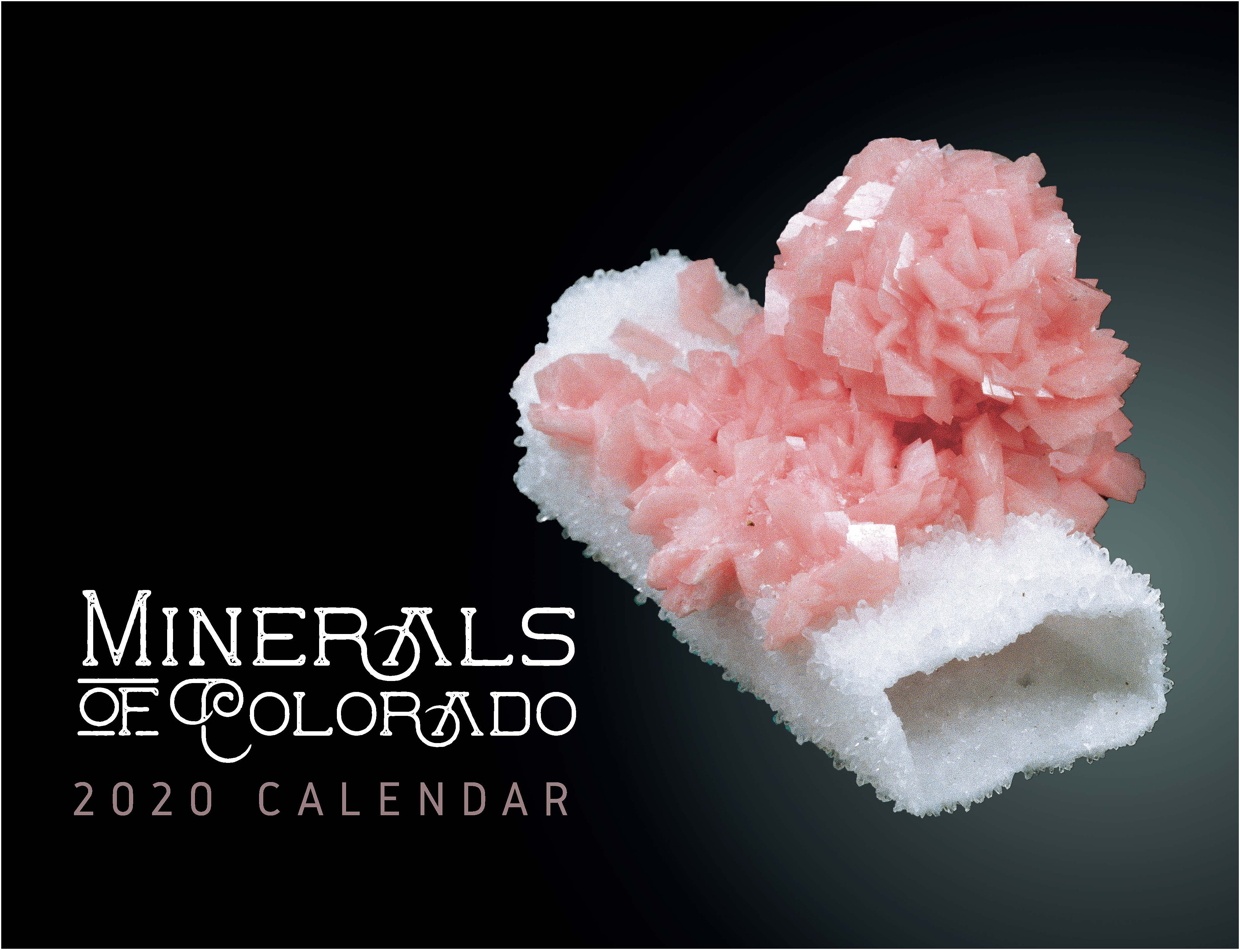
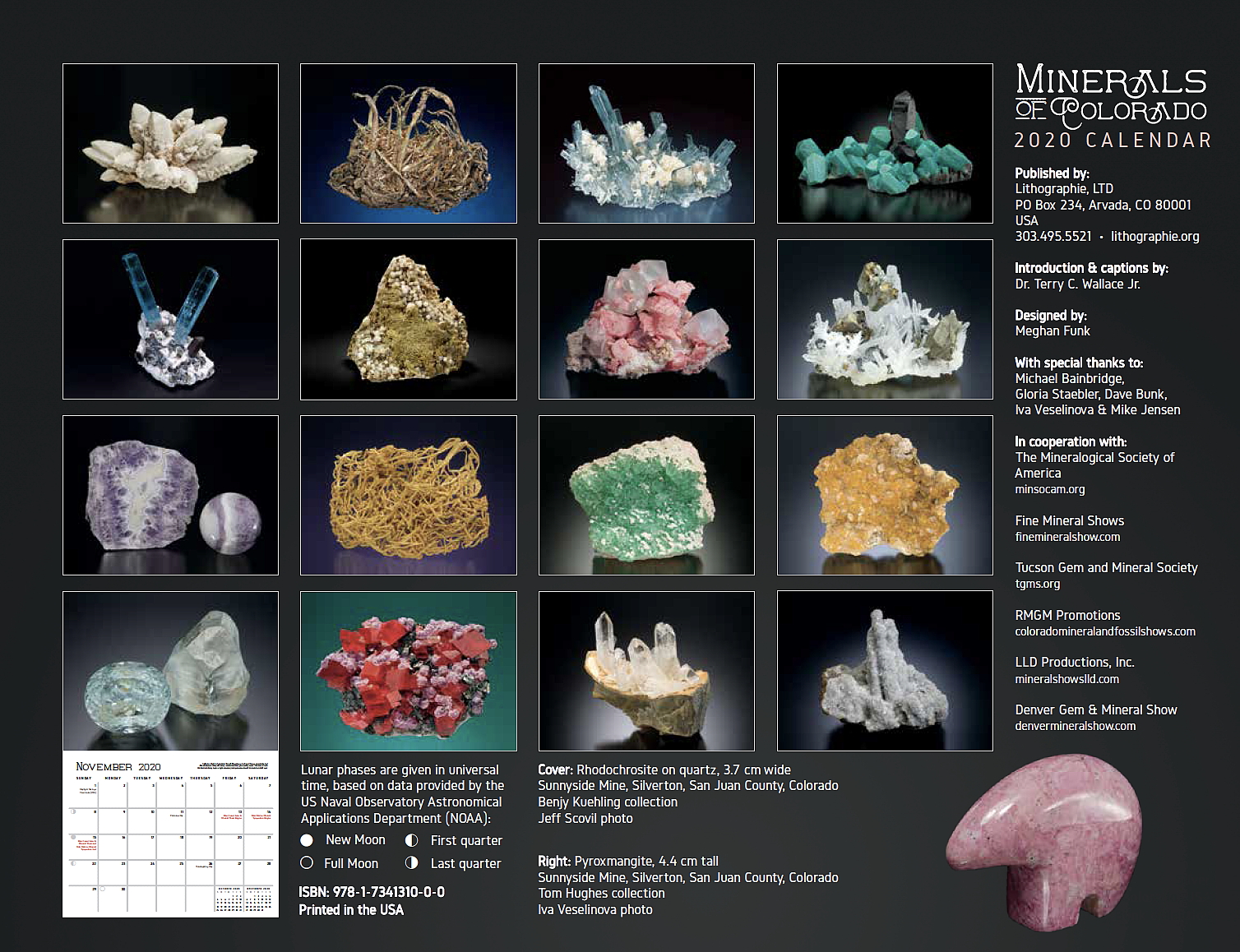
2020 Calendar: Colorado Minerals, a 16-month calendar.
Minerals of Colorado, by Terry C. Wallace Jr.Colorado's geological display is like that of no place else on Earth. The eastern half of the state is part of the Great Plains, a swath of low lying topography that was built on horizontal strata deposited by ancient seas. The Great Plains give way to the Rocky Mountains, which rise in ragged peaks six to eight thousand feet above the plains. The Rockies transition to the Colorado Plateau, a high desert of brightly colored sandstones and shales that adorn the western and southern portions of the state.
Harbored in this geologic wonderland, and inextricable from the history of the state, is a treasure trove of minerals and gemstones. First in 1850, and again in 1858, groups of prospectors discovered gold flakes in stream beds near present-day Denver. The latter find captured the imagination of a nation, and the Pikes Peak Gold Rush soon followed. "Pikes Peak or Bust" became the mantra of the more than 100,000 people who streamed into the region seeking their fortunes in what was then the Kansas Territory. In short order, the mining camps of Central City, Georgetown, Idaho Springs, Breckenridge, and Fairplay were founded.
The country fell into Civil War just a few months after the Colorado Territory was established in February 1861. Colorado's rich goldfields were targeted by both Confederate and Union strategists, but the state ultimately fell firmly into Union hands. Led by President Abraham Lincoln, the nation hoped that Colorado's mineral wealth would save the country from the massive debt accrued during the war, and mining boomed across the state. With mining came the discovery of fabulous mineral specimens, and today Colorado is home to some of the world's premier mineral specimen localities.
Today the state boasts more than 775 different mineral species, including silver, diamond, barite, quartz, amazonite, and even spectacularly colorful uranium minerals. But three species in particular stand out: deep red rhodochrosite rhombohedrons from the Sweet Home Mine, intense blue-green amazonite from the Crystal Peak area, and spectacularly crystallized gold from Breckenridge.
Mining towns like Aspen, Telluride, Crested Butte, and Breckenridge continue to draw people, but these days they come for world-class skiing and resorts. The camps' mining histories, and with them the history of the state and country, are memorialized in historic trails and museums and in the mineral specimens preserved in museums and private collections in the state, country, and around the world.
The calendar is published by Lithographie, LLC in cooperation with The Mineralogical Society of America, Martin Zinn Expositions, Tucson Gem and Mineral Society, Fine Mineral Shows, Denver Area Gem & Mineral Show, and Rocky Mountain Gems & Minerals.
=============================================================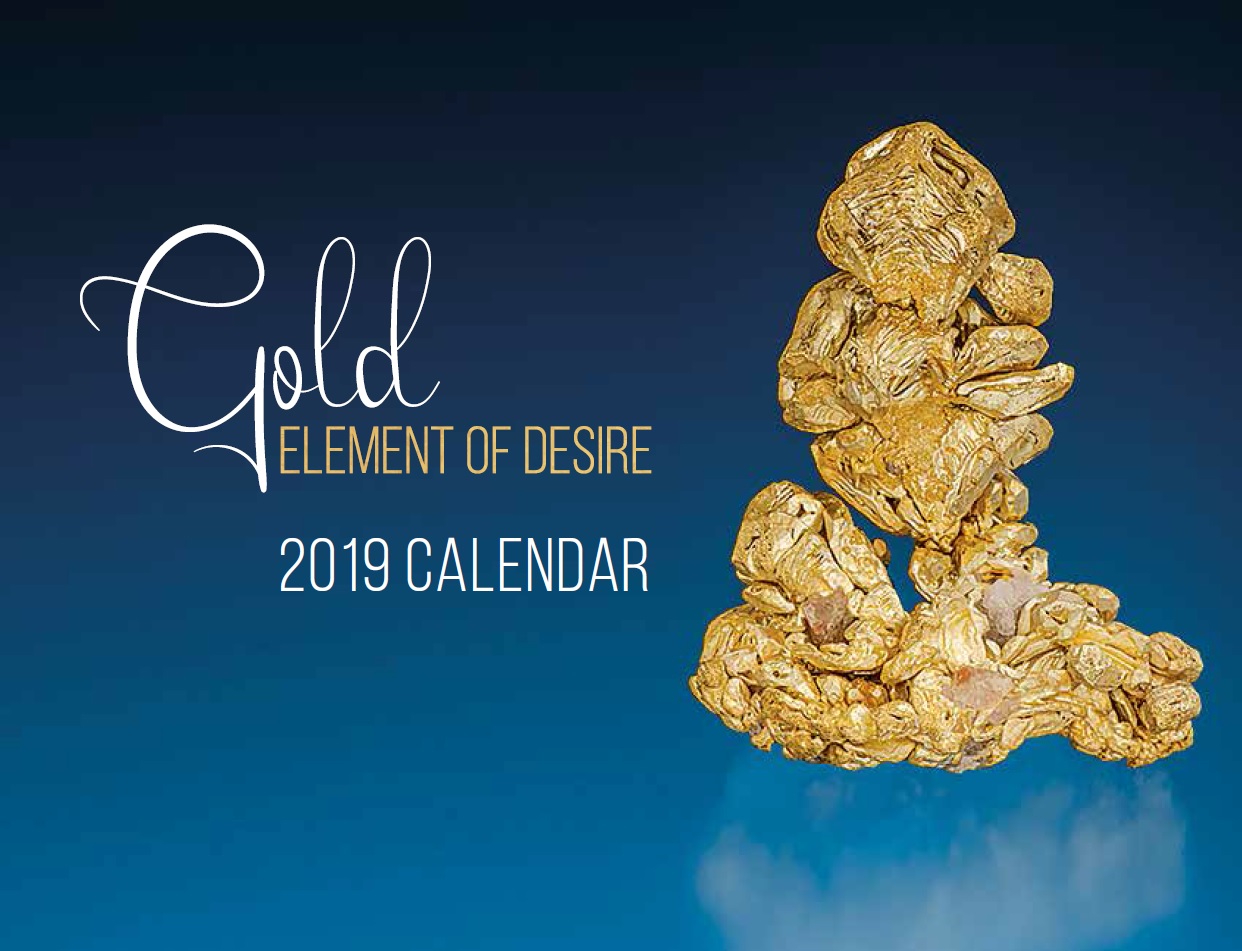
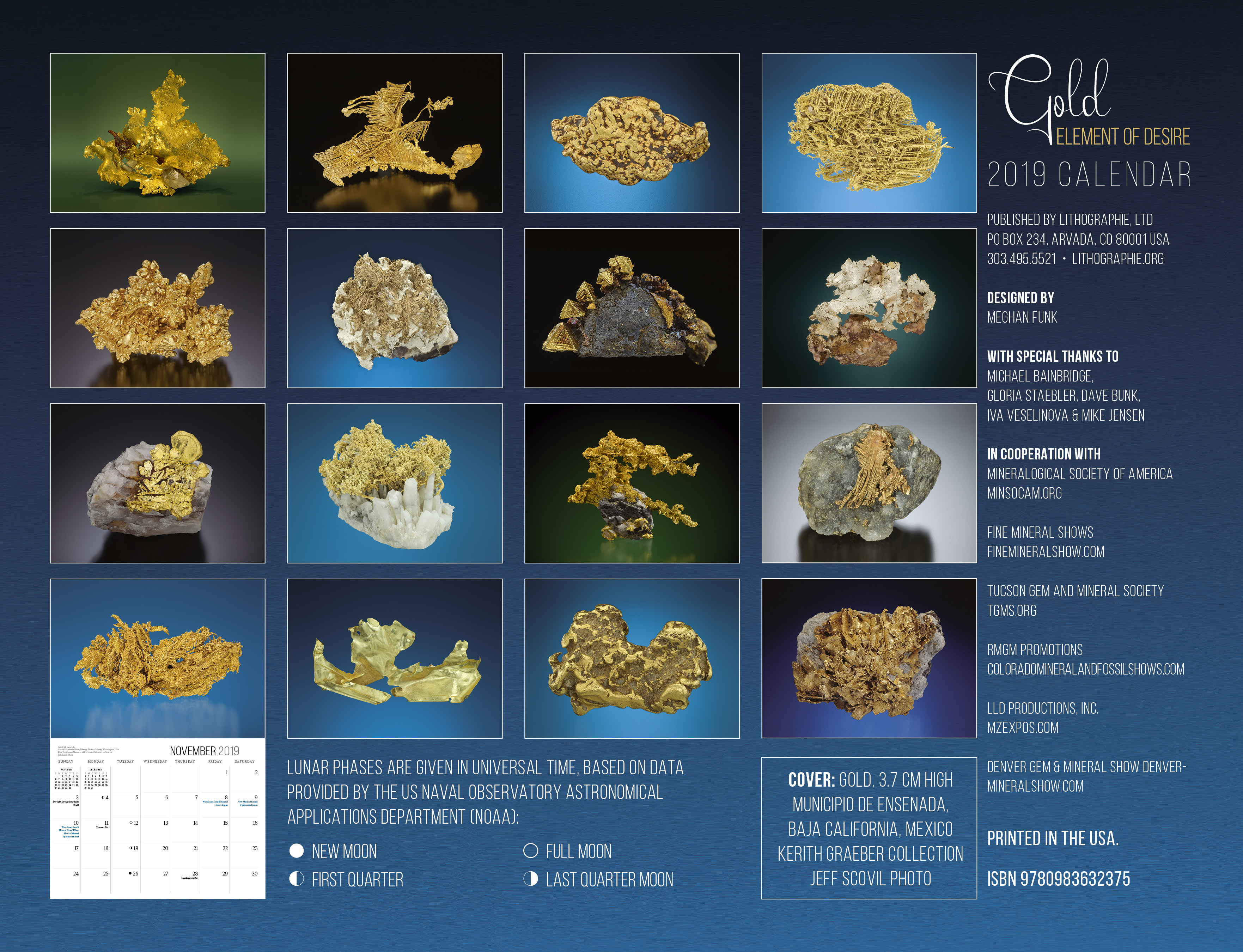
2019 Calendar: Gold - Element of Desire, a 16-month calendar.
Gold, by Robert B. CookThe exploration and settlement of the world is linked to gold more than to any other mineral. Gold is a universal currency and has symbolized the stability and wealth of individuals and nations since the dawn of history, and while it is found in the earth's crust, only a scant few have seen and can appreciate gold in its natural state. Gold is one of the dozen or so must-haves in any significant mineral collection. But fine specimens are relatively scarce and are always expensive. Fortunately, the industrial, jewelry, and monetary demand for gold is high, which keeps mines in many diverse geologic settings in operation. A few of these mines encounter specimen gold, which is often saved either clandestinely by miners or in rare instances by the mining companies themselves. The result has been a somewhat sporadic though generally continuous trickle of gold specimens in modern times.
Gold is a simple single-element mineral, the result of which is high crystal symmetry resulting in the occasional well-formed octahedron or cube. It has a decided dislike for other elements and is often seen as relatively pure nuggets or lode specimens containing only trivial matrix quartz or a few other silicates or carbonates. Interestingly, specimen-quality gold that is intimately associated with sulfides and even tellurides is relatively uncommon.
Over the past few decades spectacular California gold specimen recoveries have punctuated the collector scene. One of the most productive single finds was the Christmas Day discovery of hundreds of ounces of sheet-like gold masses at the Sonora Mining Company pit at Jamestown. Peripheral to the Mother Lode proper were other modern finds that include exceptionally well crystallized, brilliantly lustrous specimens from the Eagle's Nest Mine, phenomenal sheets from the Red Ledge Mine, well crystallized chunky masses from the Mockingbird Mine, and of course the beautifully crystallized specimens from the Colorado Quartz Mine that include the famous "Dragon." Individual specimens from these four mines have sold for over $100,000 per ounce of contained gold.
While these mines were being operated for specimen gold, others in neighboring Nevada were turning out major amounts of commercial gold and in a few cases, no small number of fine specimens. The best of these, and now a classic American gold locality, is the Round Mountain Mine. A smaller and quite different suite of gold ribbons and wires were produced for a short while from the Olinghouse Mine near Reno. Prospects like the Lokel and Wadley and Willow Creek near Winnemucca produced hundreds of spectacular and at times quite large gold specimens that were quickly gobbled up by collectors.
Other western states including Washington, Oregon, Idaho, and Colorado have been historic producers of fine gold specimens. Perhaps the best of these are the wiry and thin ribbon-like masses from Breckenridge and Leadville, Colorado, and the delicate crystalline and wire-like masses from Kittitas County, Washington. A relatively recent windfall of beautifully developed gold specimens were found on the dumps and abandoned workings of the Belshazzar Mine in Idaho.
Beyond the confines of the United States, fine gold specimens from several Canadian localities including the Goldcorp Mine at Red Lake, and small but excellent sheet-like matrix specimens from Romania have reached the collector market in recent decades. Finally, gold is often seen in hoppered or skeletal crystals. Exceptional specimens have been available in recent decades from Brazil, Venezuela, and Russia.
The accompanying photographs clearly illustrate the beauty and variety of this highly sought collector species.
The calendar is published by Lithographie, LLC in cooperation with The Mineralogical Society of America, Martin Zinn Expositions, Tucson Gem and Mineral Society, Fine Mineral Shows, Denver Area Gem & Mineral Show, and Rocky Mountain Gems & Minerals.
=============================================================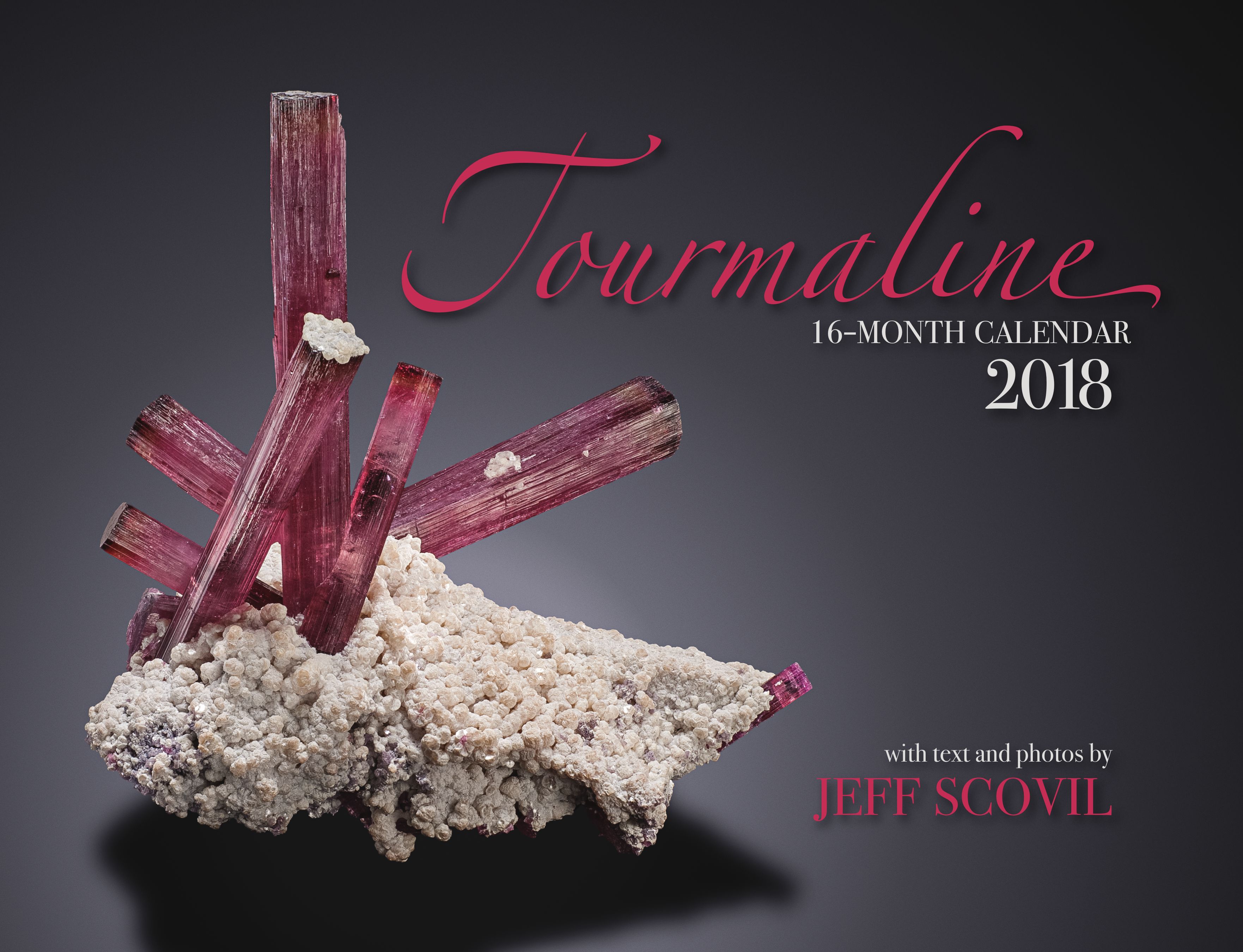
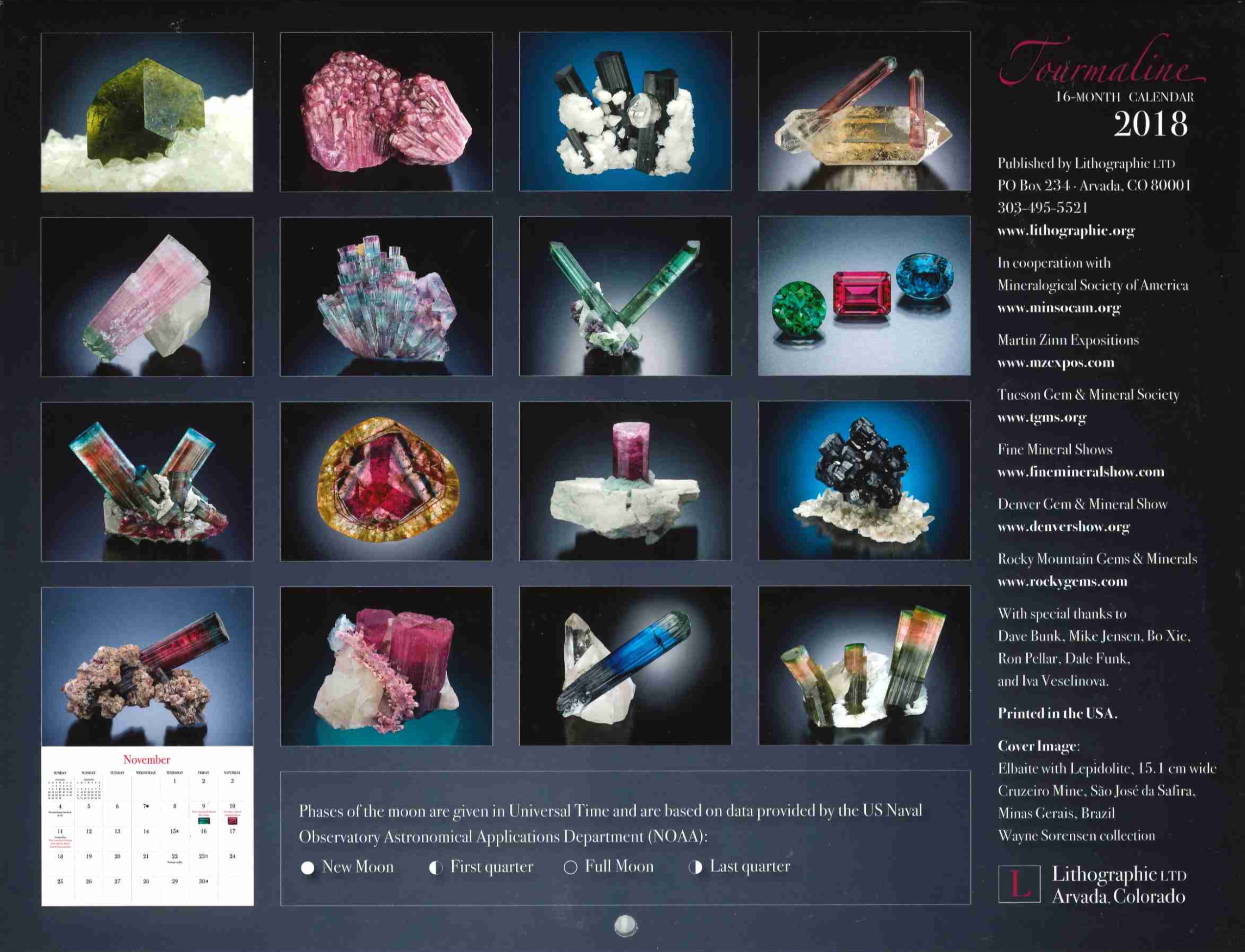
2018 Calendar: Tourmaline, a 16-month calendar.
In the gem gravels of Sri Lanka (Ceylon) any colored pebble that could not be identified was referred to in the local Tamil and Sinhalese languages as turmali, the root of the English word tourmaline. And to this day, the term tourmaline denotes not a single mineral, but a group of more than 24, related, complex silicates. Schorl, the dark, opaque, iron-rich species, is the most common tourmaline found in nature, while most of the gem material on the market is elbaite, and more rarely liddacoatite.
Tourmaline group minerals commonly occur in igneous and metamorphic rocks. Lacking value as an ore, tourmaline is primarily mined as a gem material as well as for the mineral specimen market. The gem species tend to form along with an assemblage of other minerals including quartz, beryl, and topaz, in igneous rocks known as pegmatites, while calciumrich species such as dravite and uvite more commonly occur in metamorphic settings such as marbles.
Being relatively hard (7 on the Mohs scale), having no cleavage, and occurring in colors spanning the visible spectrum, transparent tourmaline is an excellent gem material. More so given that several colors are frequently seen in a single crystal. The frequently elongated (prismatic) crystals may be zoned around their c-axes, which create concentric rings when viewed in cross section. “Watermelon” tourmalines are zoned crystals that are pink in the middle with green outer “rinds.” Popular single color varieties include “indicolite” (blue) and “rubellite” (pink to red). In recent years, the term Paraíba has been used to designate an electric-blue elbaite from the state of Paraíba in Brazil and controversially, elbaite of similar color from other localities.
Stones may be faceted or cut en cabochon, with wonderful “cabs” being fashioned from rough containing thousands of microscopic, parallel tubes to create a cat’s eye effect. For generations, carvers have worked tourmaline into beautiful, colorful sculptures. The nineteenth century Chinese Empress Dowager Cixi is said to have had a penchant for the pink tourmaline found in southern California around the turn of the century, and much of the production from San Diego County’s incredible pegmatites was shipped to China for carving.
The famous pegmatites in Minas Gerais, Brazil, are probably the most prolific sources of gem tourmaline. More recently, pegmatites in Afghanistan and Pakistan have produced superb specimens of elbaite and schorl. Other localities worldwide include, Vietnam, China, Myanmar, Madagascar, Russia, Mozambique, Nigeria and Namibia.
Elbaite is named for the Italian Isle of Elba, the source of the first studied and formally described specimens. In the United States, the first documented gem tourmaline was found in the early nineteenth century in Maine. These were followed by discoveries in Connecticut. Interest in the more modest east coast pegmatites waned as California’s rose in prominence. More than a century after their heyday, when I was in high school, I discovered the beauty of tourmaline in the crystals and crumbs that I found while digging in Connecticut’s abandoned pegmatite quarries. Those discoveries sparked a life-long passion, one that I hope emanates from these images of some of the magnificent tourmalines I have had the privilege of photographing.
Photography and text by Jeff Scovil
The calendar is published by Lithographie, LLC in cooperation with The Mineralogical Society of America, Martin Zinn Expositions, Tucson Gem and Mineral Society, Fine Mineral Shows, Denver Area Gem & Mineral Show, and Rocky Mountain Gems & Minerals.
=============================================================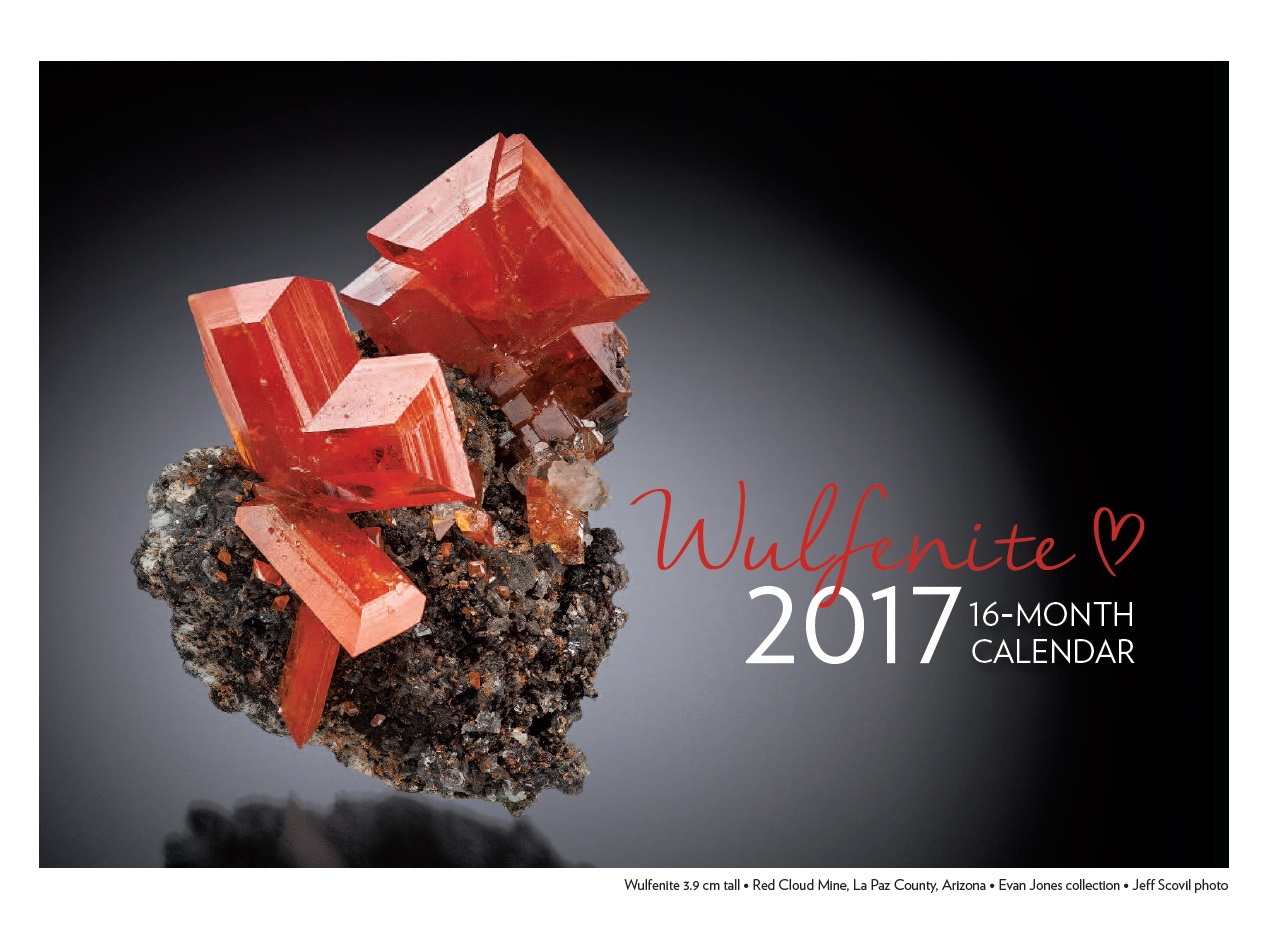
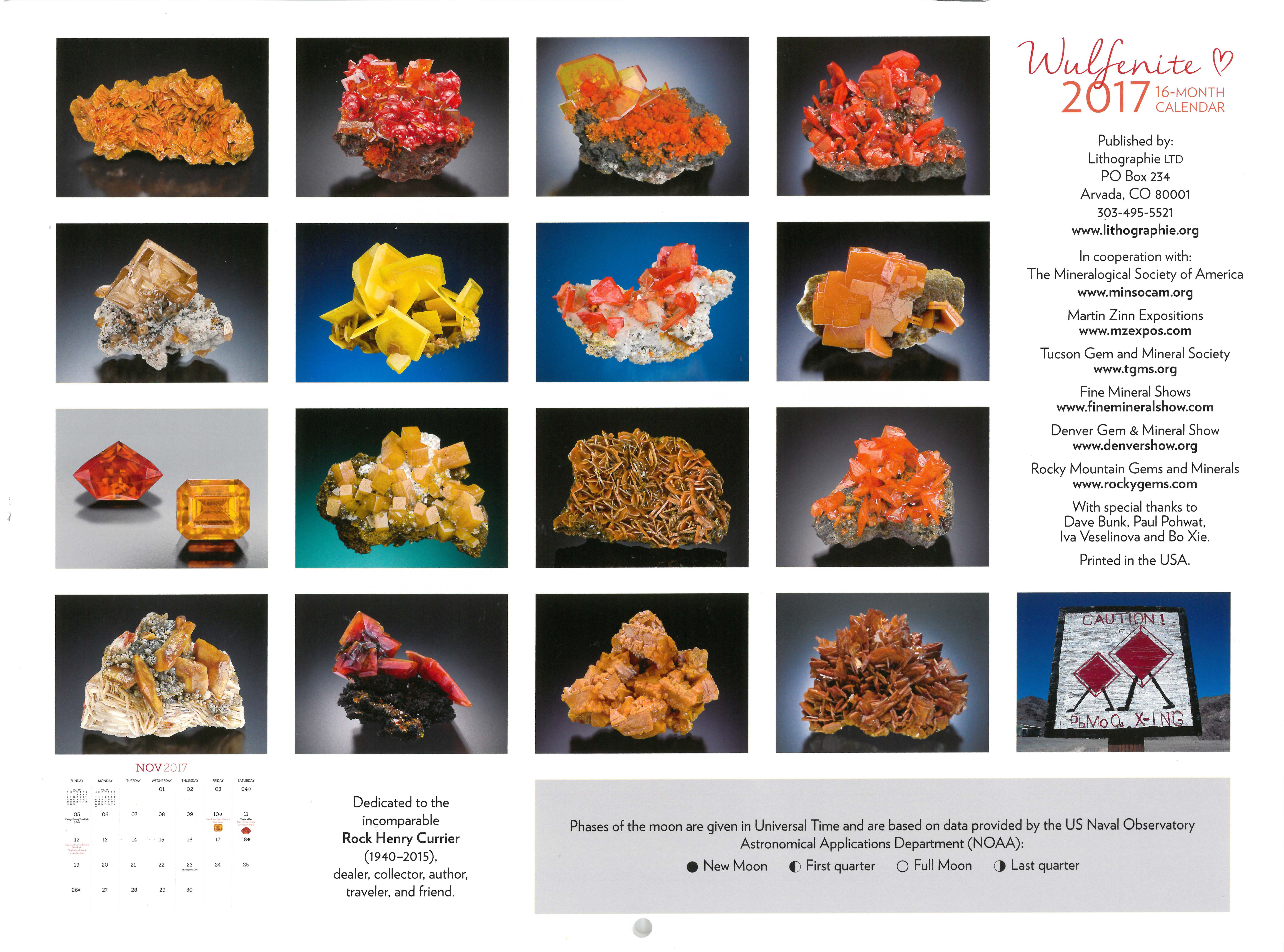
2017 Calendar: Wulfenite, a 16-month calendar.
The calendar is published by Lithographie, LLC in cooperation with The Mineralogical Society of America, Martin Zinn Expositions, Tucson Gem and Mineral Society, Fine Mineral Shows and the Greater Denver Area Gem & Mineral Council.
Wulfenite! The mineral of deserts, where weathering veins of dull and boring lead sulfide slowly suck thin traces of molybdenum out of groundwater in order to make one of nature's most beautiful minerals. The square to octagonal plates and blocky crystals come in a wide range of colors, from the most treasured bright red specimens to brilliant orange, yellow, gray, and even dark blue.
The desert regions of southern Arizona and adjacent areas of northern Mexico are home to most of the greatest occurrences. In Arizona there are the big ten: the Red Cloud, Rowley, Old Yuma, Hilltop, Glove, Total Wreck, Gleeson, 79, Tombstone, and Tiger mines, along with a host of lesser localities. Stories are still told of the day in 1938 when Ed Over broke into the world's most precious pocket of fat, brilliant red crystals in the Red Cloud Mine. Is it any wonder that plans are afoot to have wulfenite officially declared the Arizona State Mineral?
In Mexico there are more fine wulfenite localities; the most famous are the San Francisco, Los Lamentos, and Ojuela mines, as these three have yielded hundreds of thousands of wulfenite specimens over the years. Europe has excellent occurrences as well, including the Bleiberg, Austria area where wulfenite was first described by Franz Xavier von Wulfen in 1785, and the Mezica Mine in Slovenia, where intrepid collectors are still bringing out fine specimens today. But, aside from the Americas, the undisputed queen of all wulfenite localities is the famous Tsumeb Mine in Namibia, where distinctive specimens in a range of habits and colors are known, from bright yellow to cognac red-brown and colorless to gray; the very rare deep blue wulfenite from Tsumeb is colored by inclusions of ilsemannite, a molybdenum oxide.
Wulfenite occurs worldwide wherever the climate and primary minerals are conducive. Bright red crystals from Iran are small but particularly attractive, and the Jianshan mine in the equally arid Xinjiang Uygar region of northwestern China has become a modern classic locality for red to orange wulfenite. The desert areas of Morocco, as at the Dalles Mine near Mibladen, are well-known sources of orange to yellow wulfenite. And recently an old locality at M'Fouati in the Congo has been producing fine new specimens as well. These are happy days for the wulfenite collector.
The mineral most commonly associated with wulfenite seems to be botryoidal mimetite in shades from moss-green at the Ojuela Mine to yellow at the San Francisco Mine to brilliant red at the Rowley Mine. At Tsumeb, bright yellow wulfenite crystals have even been found with emerald-green dioptase-what a color combination! Thus wulfenite possesses all of the characteristics that make it a collector favorite: great color, transparency or translucency, good sized crystals, high luster, interesting crystal shapes, and attractive (often contrasting) associated species, from a widely scattered array of localities worldwide, in quantities that allow every collector to own a handsome example. The photos shown here give an inkling of the tremendous beauty that arises when lead meets molybdenum in the desert.
Previous Lithographie/MSA calendars
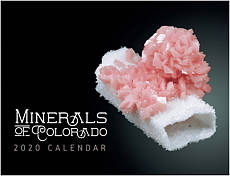
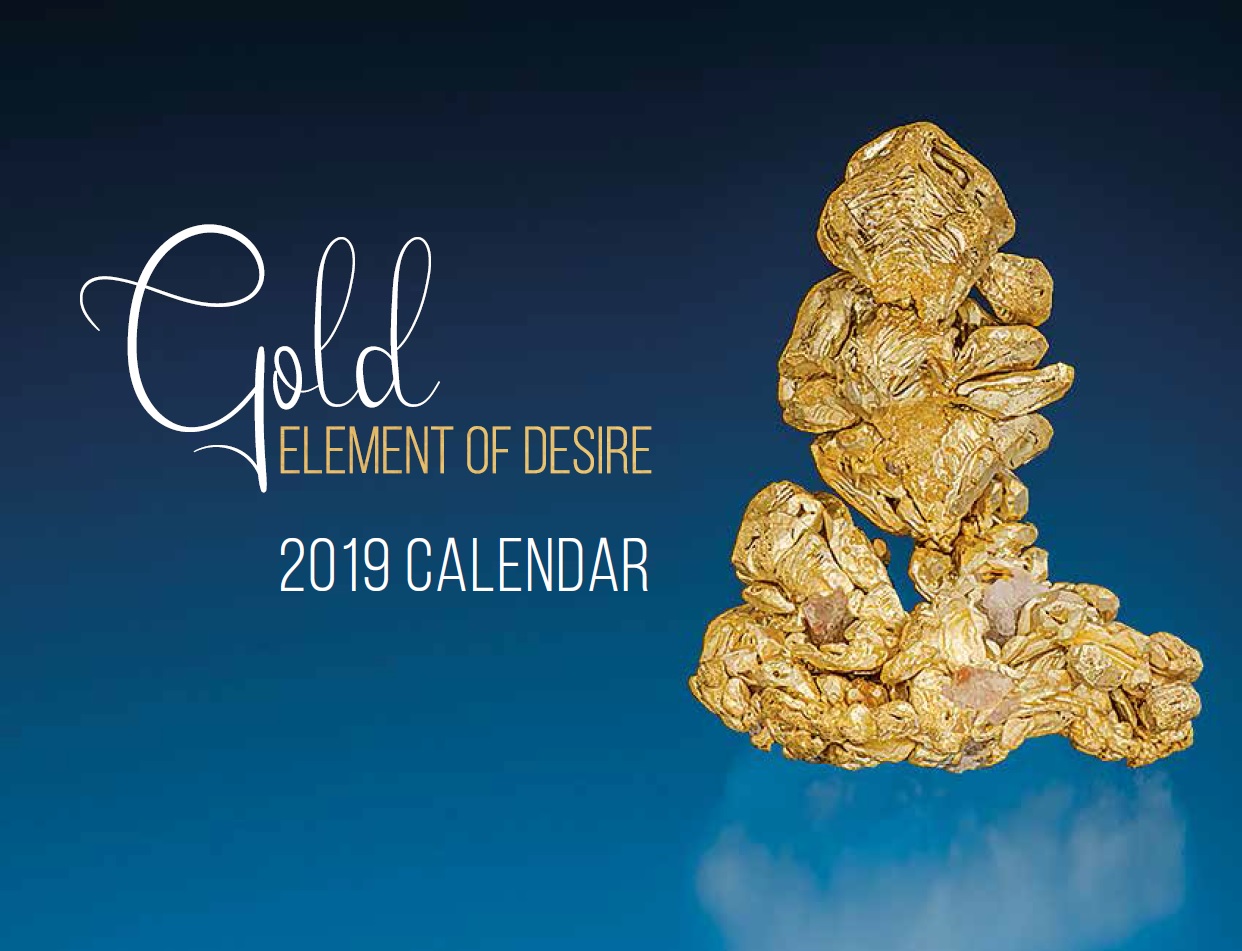
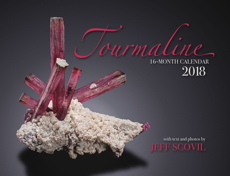
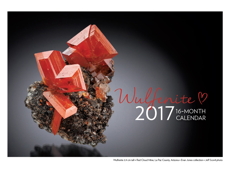
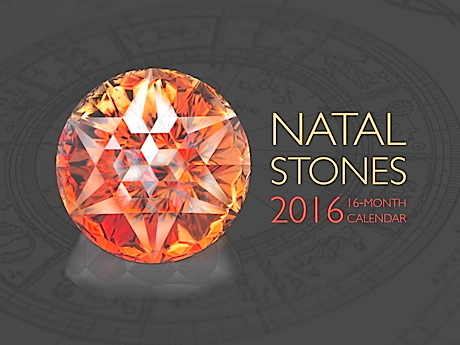
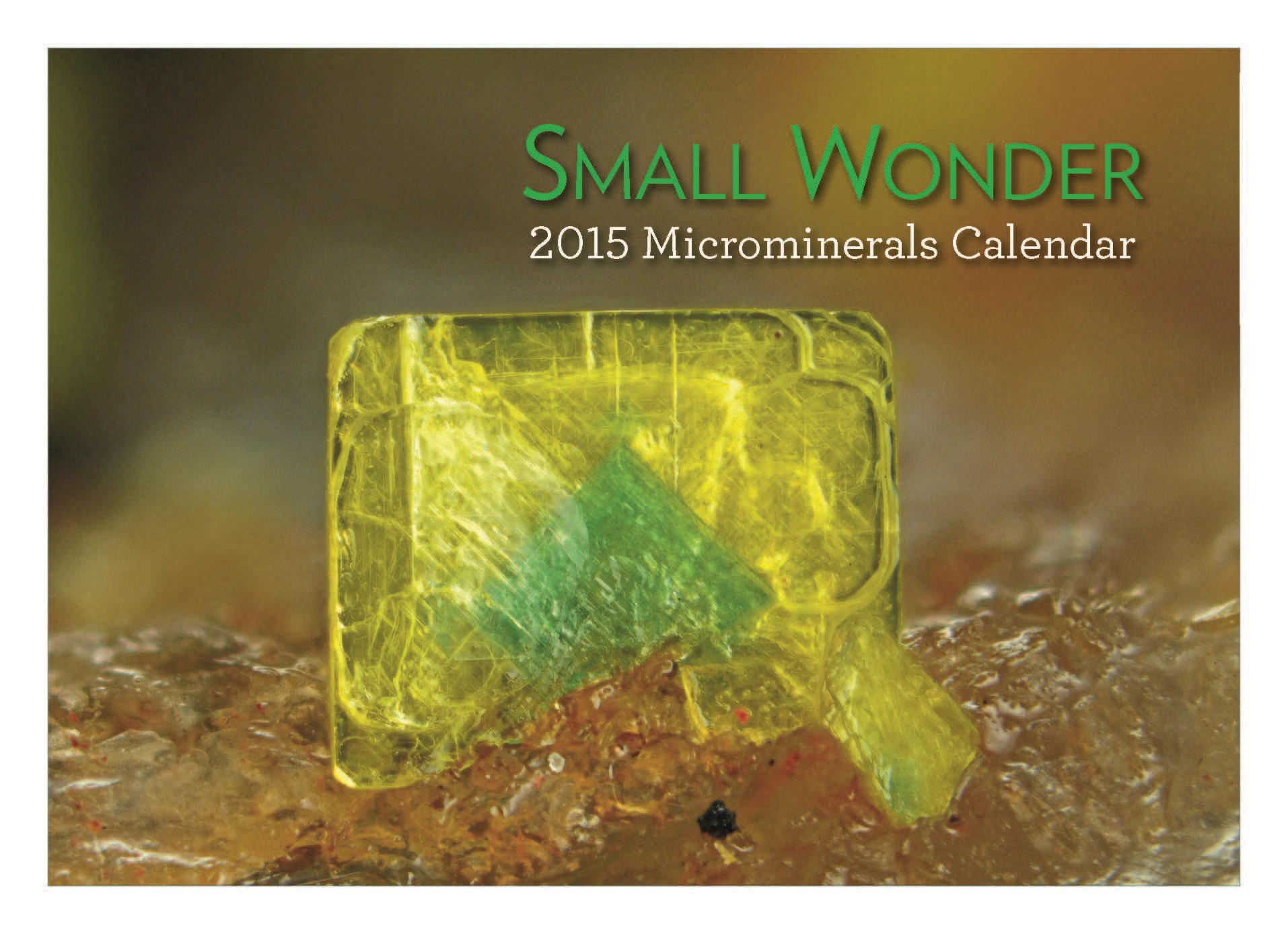
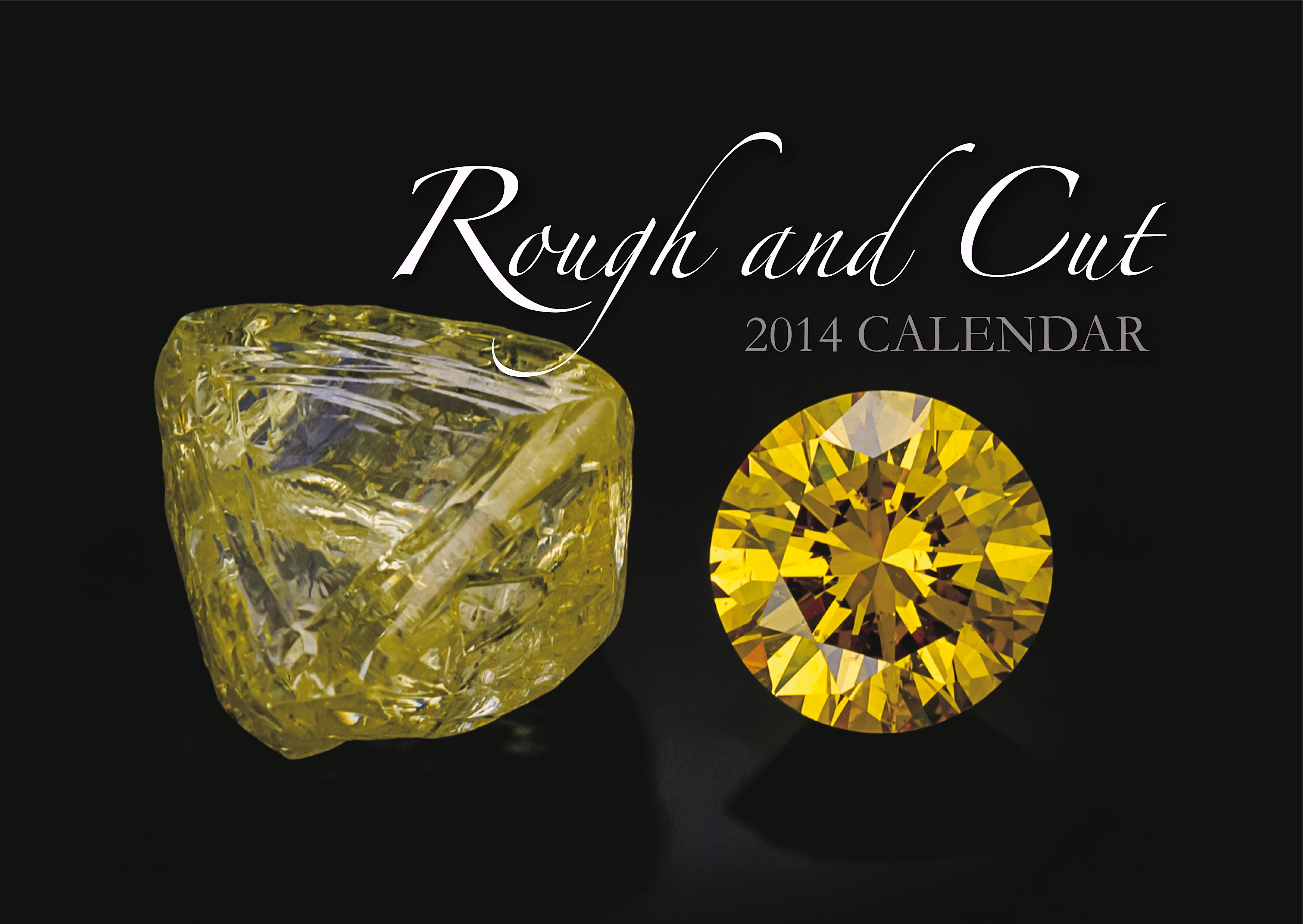
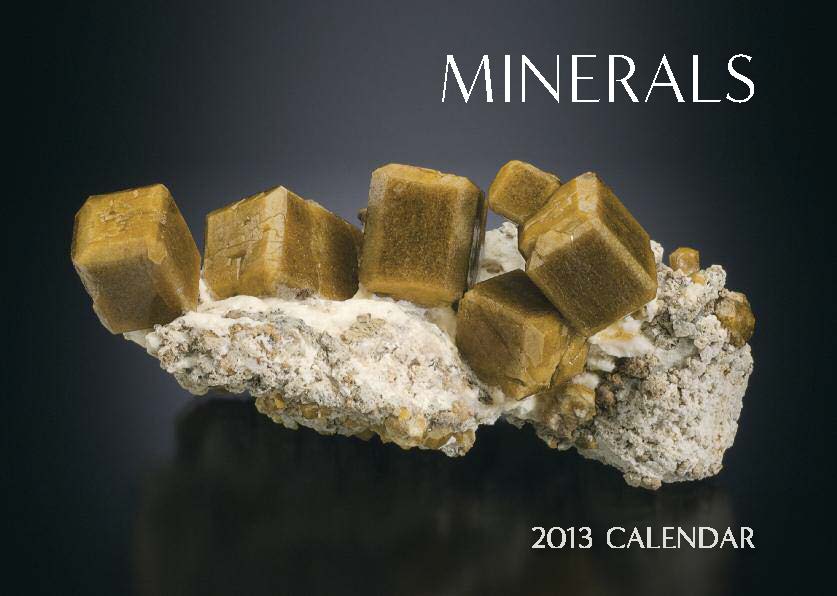
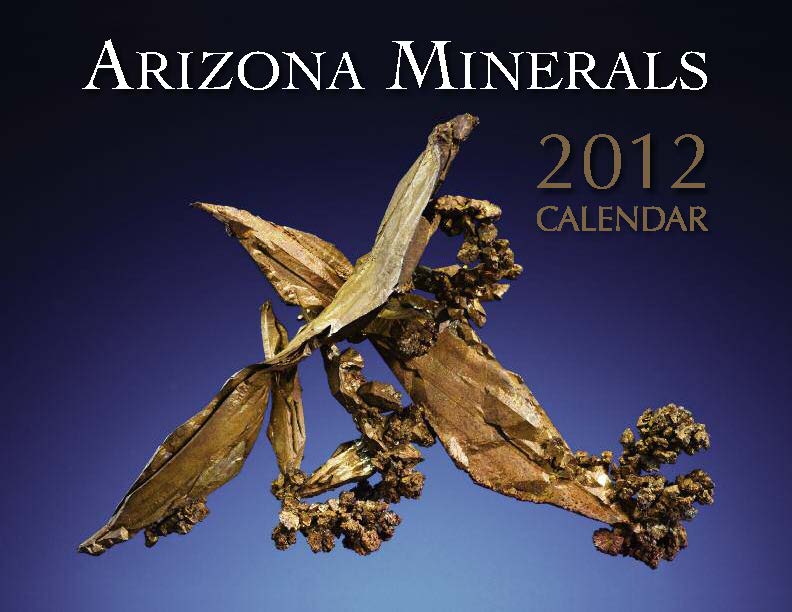
The 1998 MSA calendar
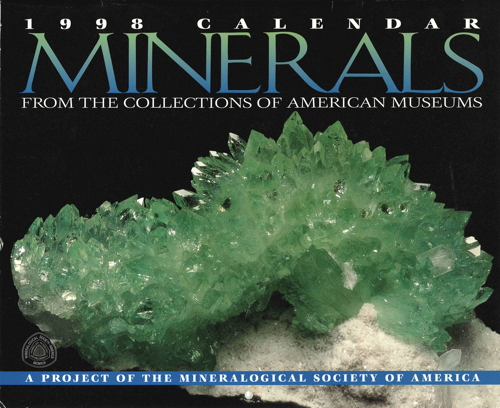
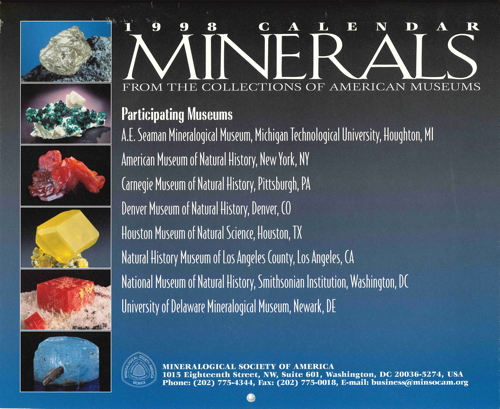

LITHOGRAPHIE, LLC Post Office Box 234, Arvada, Colorado 80001 USA
Telephone: +1 (303) 495-5521, Fax: +1 (303) 482-1238
info@lithographie.org
www.lithographie.org